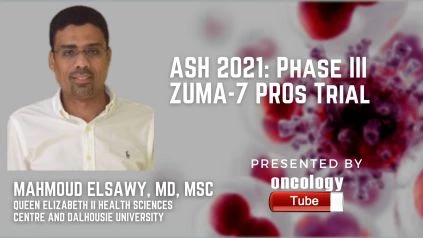Mahmoud Elsawy, MD, MSc Assistant Professor, Division of Hematology, Dalhousie University. Medical Director of IEC Therapy Program, QEII Health Sciences Center, NS, Canada speaks about the ASH 2021 Abstract – 430 Patient-Reported Outcomes in a Phase 3, Randomized, Open-Label Study Evaluating the Efficacy of Axicabtagene Ciloleucel (Axi-Cel) Versus Standard of Care Therapy in Patients with Relapsed/Refractory Large B-Cell Lymphoma (ZUMA-7).
Link to Abstract:
https://ash.confex.com/ash/2021/webprogram/Paper147598.html
Background:
Patients with large B-cell lymphoma (LBCL) who relapse early or are unresponsive to first-line therapy have dismal outcomes. Furthermore, patients receiving second-line standard-of-care (SOC) therapy frequently report a low quality of life connected to their health (QoL; Lin V, et al. J Clin Oncol. 2020;38:e20070). We conducted the first comparative analysis of patient-reported outcomes (PROs) with CAR T-cell therapy versus SOC as second-line treatment in relapsed/refractory (R/R) LBCL in the ZUMA-7 (NCT03391466) pivotal Phase 3 randomized, open-label, multicenter study of axi-cel (an autologous anti-CD19 chimeric antigen receptor [CAR] T-cell therapy) versus SOC.
Methods: PRO instruments, such as the EORTC QLQ-C30 (a 30-item cancer-specific questionnaire with global health status, functional, and symptom scales) and the EQ-5D-5L (a general questionnaire with five QoL domains plus a global assessment), were administered at baseline (prior to treatment), Day 50, Day 100, Day 150, Month 9, and every 3 months from randomization up to 24 months or the time of event-free survival event (disease progression, death All patients who had a baseline PRO and 1 measure completed at Day 50, Day 100, or Day 150 were included in the QoL analysis set. A mixed-effect model with repeated measures was used to test prespecified hypotheses for three PRO domains (EORTC QLQ-C30 Physical Functioning, EORTC QLQ-C30 Global Health Status/QoL, and EQ-5D-5L visual analog scale [VAS]) at Day 100 and subsequent time points if previous time points were statistically significant. P values were adjusted using the False Discovery Rate across important endpoints, and sensitivity analyses were applied to account for variables and missingness patterns. Each EORTC QLQ-C30 score was given a clinically relevant change of 10 points, and the EQ-5D-5L VAS score was given a clinically meaningful change of 7 points. Exploratory assessments of other EORTC QLQ-C30 and EQ-5D-5L domains were also conducted.
Results:
296 participants (165 axi-cel, 131 SOC) were included in the ZUMA-7 study since they had baseline PROs and at least one follow-up measure. In total, 70% of patients had a primary refractory illness, 42% had a high second-line age-adjusted International Prognostic Index (2–3), and 30% were under the age of 65.
On all prespecified PRO domains, there was a statistically significant (P.0001) and clinically relevant difference in mean change of scores from baseline at Day 100 in favor of axi-cel for patients in the QoL analysis set treated with axi-cel versus SOC (Figure). At Day 100, sensitivity analysis revealed comparable results with the same level of significance. At Day 150, EORTC QLQ-C30 Global Health Status/QoL (P=.0124) and EQ-5D-5L VAS (P=.0004) ratings substantially favored axi-cel versus SOC. By day 150, the mean projected scores for the axi-cel arm had numerically recovered to or above baseline scores for the prespecified endpoints, compared to on or after Month 9 for the SOC arm. After Month 9, there was a significant amount of attrition in the QoL analysis set, particularly in the SOC arm (due to illness progression, new lymphoma therapy, or death).
Additional exploratory studies of PRO endpoints (such as the EORTC QLQ-C30 role functioning, social functioning, fatigue, nausea/vomiting, dyspnea, sleeplessness, appetite loss, diarrhea, and the EQ-5D-5L index [US value set]) revealed that axi-cel outperformed SOC.
Conclusion:
The first randomized, worldwide, multicenter Phase 3 research of axi-cel versus SOC in second-line R/R LBCL, ZUMA-7, found that treatment with axi-cel improves QoL clinically meaningfully above SOC at Day 100, as measured by various validated PRO tools. Attrition owing to illness progression, new lymphoma therapy, or death may select participants with the greatest results, therefore score comparisons at later timepoints should be interpreted with caution, especially in the SOC arm. In comparison to SOC, the data also imply that axi-cel provides a faster return to pretreatment QoL. The advantages of axi-cel over SOC in terms of clinical outcomes and patient experience should help guide treatment decisions in second-line R/R LBCL.

